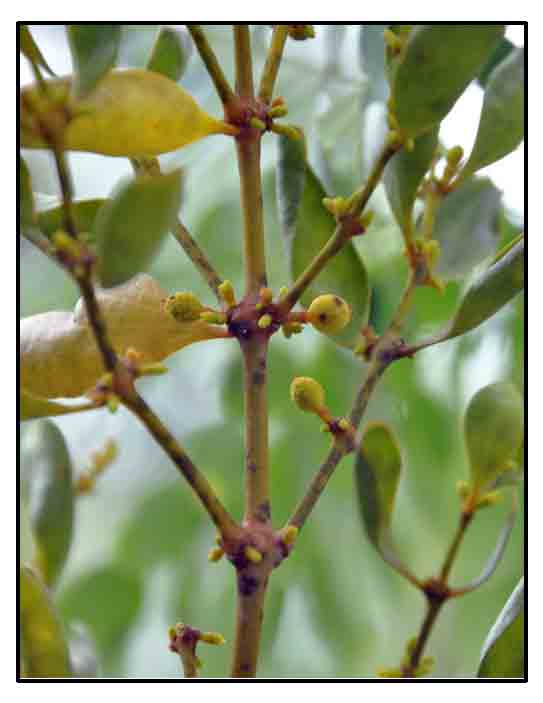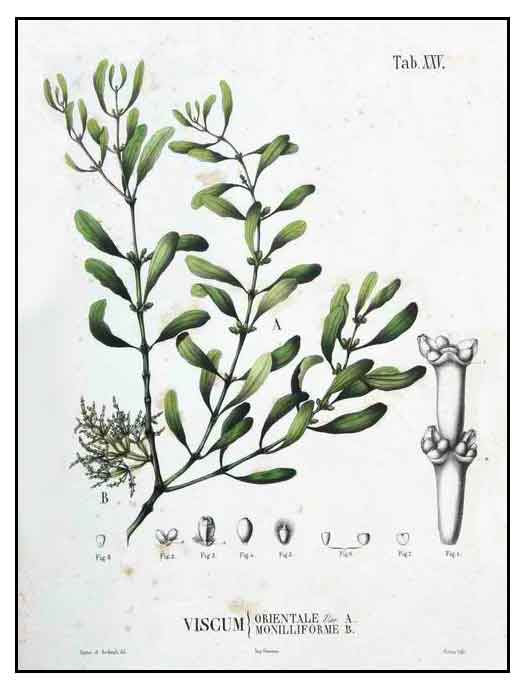
Family • Santalaceae
Bogto
DYER'S OLEANDER MISTLETOE / ORIENTAL MISTLETOE
Viscum orientale Willd.
| Scientific names | Common names |
| Fusanus parasiticus Blanco | Bogto (Tagalog) |
| Viscum montanum Zoll. & Moritzi | Dyer's oleander mistletoe (Engl.) |
| Viscum navicellatum Korth. | Oriental mistletoe (Engl.) |
| Viscum orientale Willd. | |
| Viscum pamattonis Korth. | |
| Viscum roxburghianum Korth. | |
| Viscum verticillatum Roxb. | |
| Viscum verticilliflorum Royle | |
| Quisumbing's compilation lists many synonyms for Viscum orientale, many of which are not listed as Viscum species with The Plant List, only a few are accepted names: V. ovalifoilium (accepted, no synonym), V. monoicum Roxb. ex DC. (accepted, no synonym). The rest of the synonyms in his compilation are unresolved names:Viscum heyneanum DC., Viscum obtusatum DC., Viscum verticillatum Roxb., Viscum pamattonis Korth., Viscum roxburghiana Korth., Viscum navicellatum Korth., Viscum philippense Llanos, while Viscum opuntioides Cav. is unlisted. | |
| Note: There are significant differences in synonyms presented by Quisumbing's compilation, The Plant List, and Plants of the World Online. I am using POWO's synonym listing, and Bogto as common name. | |
| Note: Bogto is a local name shared with Viscum ovalifolium. | |
| Viscum orientale Willd. is an accepted species. It lists 7 synonyms KEW: Plants of the World Online | |
| Other vernacular names |
| BENGALI: Banda. |
| INDIA: Banda (Hindi); Dare-banda, Madang; Asareganda, Asura banda, Hasari banda Kannada); Itthikanni (Malayalam); Bajinika, Chandrabadanika, Kammi badanika, Sundarabadanika (Telugu). |
Updated November 2025 /October 2018 / March 2013
![]()
 |
PHOTOS / ILLUSTRATIONS |
| IMAGE SOURCE: / Photo / Viscum orientale / Copyright © 2012 by P.B. Pelser & J.F. Barcelona (contact: pieter.pelser@canterbury.ac.nz) [ref. DOL52015] / Non-Commercial Use / click on image to go to source page / Phytoimages.siu.edu |
| OTHER IMAGE SOURCE: Viscum orientale. / © Vikas D Prasad / Some rights reserved . CC BY-SA 4.0 International Deed / Image modified / Click on image or link to go to source page / iNaturalist |
| OTHER IMAGE SOURCE: Viscum orientale. / © Arun N / Some rights reserved . CC BY-NC 4.0 International Deed / Click on image or link to go to source page / iNaturalist |
| OTHER IMAGE SOURCE: Viscum orientale. Sixtus & Arckenh. del. Sixtus lith. Chr.litho. 45 x 27,5 cm From: Flore Javae. Tab. XXIV. / C.L.Blume (1789-1862) FLORE JAVAE .(Flora of Java), Brussels, 1829. / Botanical Prints / Xeno Art |
Additional
Sources and Suggested Readings |
• |
DOI: It is not uncommon for links on studies/sources to change. Copying and pasting the information on the search window or using the DOI (if available) will often redirect to the new link page. (Citing and Using a (DOI) Digital Object Identifier) |
| List of Understudied Philippine Medicinal Plants |
| New plant names needed The compilation now numbers over 1,720 medicinal plants. While I believe there are hundreds more that can be added to the collection, they are becoming more difficult to find. If you have a plant to suggest for inclusion, native or introduced, please email the info: scientific name (most helpful), local plant name (if known), any known folkloric medicinal use, and, if possible, a photo. Your help will be greatly appreciated. |
• |
 |


 Constituents
Constituents IL-1ß, IL-6, and CRP) and NO markedly increased by carrageenan were significantly reduced by V. orientale. It was also one of four Viscum species that showed cytotoxicity towards four types of human breast cancer cell lines. All six species showed considerable anti-tumor activity against EAC (Ehrlich Ascites Carcinoma) cell induced ascites tumor, and one of four species that reduced solid tumor induced by DLA (Dalton's Lymphoma Ascites) cells. (
IL-1ß, IL-6, and CRP) and NO markedly increased by carrageenan were significantly reduced by V. orientale. It was also one of four Viscum species that showed cytotoxicity towards four types of human breast cancer cell lines. All six species showed considerable anti-tumor activity against EAC (Ehrlich Ascites Carcinoma) cell induced ascites tumor, and one of four species that reduced solid tumor induced by DLA (Dalton's Lymphoma Ascites) cells. (